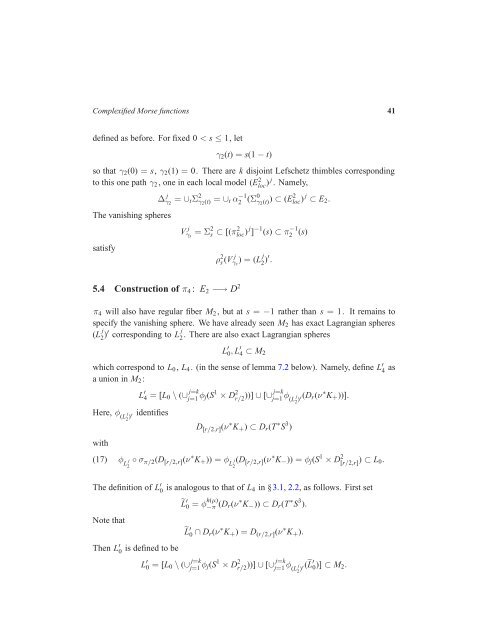The Picard-Lefschetz theory of complexified Morse functions 1 ...
The Picard-Lefschetz theory of complexified Morse functions 1 ...
The Picard-Lefschetz theory of complexified Morse functions 1 ...
You also want an ePaper? Increase the reach of your titles
YUMPU automatically turns print PDFs into web optimized ePapers that Google loves.
Complexified <strong>Morse</strong> <strong>functions</strong> 41<br />
defined as before. For fixed 0 < s ≤ 1, let<br />
γ2(t) = s(1 − t)<br />
so that γ2(0) = s, γ2(1) = 0. <strong>The</strong>re are k disjoint <strong>Lefschetz</strong> thimbles corresponding<br />
to this one path γ2, one in each local model (E 2 loc ) j . Namely,<br />
<strong>The</strong> vanishing spheres<br />
satisfy<br />
∆ j γ2 = ∪tΣ 2 γ2(t) = ∪t α −1<br />
2 (Σ0 γ2(t) ) ⊂ (E2 loc) j ⊂ E2.<br />
5.4 Construction <strong>of</strong> π4 : E2 −→ D 2<br />
V j γs = Σ2 s ⊂ [(π 2 loc) j ] −1 (s) ⊂ π −1<br />
2 (s)<br />
ρ 2 s (V j j<br />
γs ) = (L2 )′ .<br />
π4 will also have regular fiber M2, but at s = −1 rather than s = 1. It remains to<br />
specify the vanishing sphere. We have already seen M2 has exact Lagrangian spheres<br />
(L j<br />
. <strong>The</strong>re are also exact Lagrangian spheres<br />
2 )′ corresponding to L j<br />
2<br />
L ′ 0, L ′ 4 ⊂ M2<br />
which correspond to L0, L4. (in the sense <strong>of</strong> lemma 7.2 below). Namely, define L ′ 4 as<br />
a union in M2:<br />
L ′ 4 = [L0 \ (∪ j=k<br />
j=1φj(S 1 × D 2 j=k<br />
r/2 ))] ∪ [∪j=1φ (L j<br />
2 )′(Dr(ν ∗ K+))].<br />
Here, φ j<br />
(L2 )′ identifies<br />
D [r/2,r](ν ∗ K+) ⊂ Dr(T ∗ S 3 )<br />
with<br />
(17)<br />
φ L j<br />
2<br />
◦ σπ/2(D [r/2,r](ν ∗ K+)) = φ j(D<br />
L [r/2,r](ν<br />
2<br />
∗ K−)) = φj(S 1 × D 2 [r/2,r] ) ⊂ L0.<br />
<strong>The</strong> definition <strong>of</strong> L ′ 0 is analogous to that <strong>of</strong> L4 in §3.1, 2.2, as follows. First set<br />
Note that<br />
<strong>The</strong>n L ′ 0<br />
is defined to be<br />
L ′ 0 = φ h(µ)<br />
−π (Dr(ν ∗ K−)) ⊂ Dr(T ∗ S 3 ).<br />
L ′ 0 ∩ Dr(ν ∗ K+) = D (r/2,r](ν ∗ K+).<br />
L ′ 0 = [L0 \ (∪ j=k<br />
j=1 φj(S 1 × D 2 r/2 ))] ∪ [∪ j=k<br />
j=1 φ (L j<br />
2 )′(L ′ 0)] ⊂ M2.
















